2. Stone DM, Simon TR, Fowler KA, Kegler SR, Yuan K, Holland KM, et al. Vital signs: trends in state suicide rates - United States, 1999–2016 and circumstances contributing to suicide - 27 states, 2015. MMWR Morb Mortal Wkly Rep. 2018; 67(22):617–624. PMID:
29879094.

3. Hawton K, Bergen H, Cooper J, Turnbull P, Waters K, Ness J, et al. Suicide following self-harm: findings from the Multicentre Study of self-harm in England, 2000–2012. J Affect Disord. 2015; 175:147–151. PMID:
25617686.

4. Finkelstein Y, Macdonald EM, Hollands S, Sivilotti ML, Hutson JR, Mamdani MM, et al. Risk of suicide following deliberate self-poisoning. JAMA Psychiatry. 2015; 72(6):570–575. PMID:
25830811.

5. Leon AC, Friedman RA, Sweeney JA, Brown RP, Mann JJ. Statistical issues in the identification of risk factors for suicidal behavior: the application of survival analysis. Psychiatry Res. 1990; 31(1):99–108. PMID:
2315425.

6. Crump C, Sundquist K, Sundquist J, Winkleby MA. Sociodemographic, psychiatric and somatic risk factors for suicide: a Swedish national cohort study. Psychol Med. 2014; 44(2):279–289. PMID:
23611178.

7. Otaka Y, Arakawa R, Narishige R, Okubo Y, Tateno A. Suicide decline and improved psychiatric treatment status: longitudinal survey of suicides and serious suicide attempters in Tokyo. BMC Psychiatry. 2022; 22(1):221. PMID:
35351060.

8. Sveticic J, De Leo D. The hypothesis of a continuum in suicidality: a discussion on its validity and practical implications. Ment Illn. 2012; 4(2):e15. PMID:
25478116.

9. Kawashima Y, Yonemoto N, Inagaki M, Yamada M. Prevalence of suicide attempters in emergency departments in Japan: a systematic review and meta-analysis. J Affect Disord. 2014; 163:33–39. PMID:
24836085.

10. Betz ME, Wintersteen M, Boudreaux ED, Brown G, Capoccia L, Currier G, et al. Reducing suicide risk: challenges and opportunities in the emergency department. Ann Emerg Med. 2016; 68(6):758–765. PMID:
27451339.

11. Freeman J, Strauss P, Hamilton S, Pugh C, Browne K, Caren S, et al. They told me “this isn’t a hotel”: young people’s experiences and perceptions of care when presenting to the emergency department with suicide-related behaviour. Int J Environ Res Public Health. 2022; 19(3):1377. PMID:
35162409.

12. Lewitzka U, Sauer C, Bauer M, Felber W. Are national suicide prevention programs effective? A comparison of 4 verum and 4 control countries over 30 years. BMC Psychiatry. 2019; 19(1):158. PMID:
31122215.

13. Sung HK, Paik JH, Lee YJ, Kang S. Impact of the COVID-19 outbreak on emergency care utilization in patients with acute myocardial infarction: a nationwide population-based study. J Korean Med Sci. 2021; 36(16):e111. PMID:
33904263.

14. Lee KS, Lim D, Paik JW, Choi YY, Jeon J, Sung HK. Suicide attempt-related emergency department visits among adolescents: a nationwide population-based study in Korea, 2016–2019. BMC Psychiatry. 2022; 22(1):418. PMID:
35733111.

15. Posner K, Oquendo MA, Gould M, Stanley B, Davies M. Columbia Classification Algorithm of Suicide Assessment (C-CASA): classification of suicidal events in the FDA’s pediatric suicidal risk analysis of antidepressants. Am J Psychiatry. 2007; 164(7):1035–1043. PMID:
17606655.

16. Boserup B, McKenney M, Elkbuli A. The impact of the COVID-19 pandemic on emergency department visits and patient safety in the United States. Am J Emerg Med. 2020; 38(9):1732–1736. PMID:
32738468.

17. Pak YS, Ro YS, Kim SH, Han SH, Ko SK, Kim T, et al. Effects of emergency care-related health policies during the COVID-19 pandemic in Korea: a quasi-experimental study. J Korean Med Sci. 2021; 36(16):e121. PMID:
33904264.

18. Hartnett KP, Kite-Powell A, DeVies J, Coletta MA, Boehmer TK, Adjemian J, et al. Impact of the COVID-19 pandemic on emergency department visits - United States, January 1, 2019–May 30, 2020. MMWR Morb Mortal Wkly Rep. 2020; 69(23):699–704. PMID:
32525856.

19. Czeisler MÉ, Lane RI, Petrosky E, Wiley JF, Christensen A, Njai R, et al. Mental health, substance use, and suicidal ideation during the COVID-19 pandemic - United States, June 24–30, 2020. MMWR Morb Mortal Wkly Rep. 2020; 69(32):1049–1057. PMID:
32790653.

20. Dubé JP, Smith MM, Sherry SB, Hewitt PL, Stewart SH. Suicide behaviors during the COVID-19 pandemic: a meta-analysis of 54 studies. Psychiatry Res. 2021; 301:113998. PMID:
34022657.

21. O’Connor RC, Wetherall K, Cleare S, McClelland H, Melson AJ, Niedzwiedz CL, et al. Mental health and well-being during the COVID-19 pandemic: longitudinal analyses of adults in the UK COVID-19 mental health & wellbeing study. Br J Psychiatry. 2021; 218(6):326–333. PMID:
33081860.

22. Niedzwiedz CL, Green MJ, Benzeval M, Campbell D, Craig P, Demou E, et al. Mental health and health behaviours before and during the initial phase of the COVID-19 lockdown: longitudinal analyses of the UK household longitudinal study. J Epidemiol Community Health. 2021; 75(3):224–231. PMID:
32978210.

23. Ueda M, Nordström R, Matsubayashi T. Suicide and mental health during the COVID-19 pandemic in Japan. J Public Health (Oxf). 2022; 44(3):541–548. PMID:
33855451.

24. Goldman-Mellor SJ, Caspi A, Harrington H, Hogan S, Nada-Raja S, Poulton R, et al. Suicide attempt in young people: a signal for long-term health care and social needs. JAMA Psychiatry. 2014; 71(2):119–127. PMID:
24306041.
25. Lee J, Bang YS, Min S, Ahn JS, Kim H, Cha YS, et al. Characteristics of adolescents who visit the emergency department following suicide attempts: comparison study between adolescents and adults. BMC Psychiatry. 2019; 19(1):231. PMID:
31349782.

26. Owens D, Horrocks J, House A. Fatal and non-fatal repetition of self-harm. Systematic review. Br J Psychiatry. 2002; 181(3):193–199. PMID:
12204922.
27. Christiansen E, Jensen BF. Risk of repetition of suicide attempt, suicide or all deaths after an episode of attempted suicide: a register-based survival analysis. Aust N Z J Psychiatry. 2007; 41(3):257–265. PMID:
17464707.

28. Yamasaki A, Sakai R, Shirakawa T. Low income, unemployment, and suicide mortality rates for middle-age persons in Japan. Psychol Rep. 2005; 96(2):337–348. PMID:
15941108.

29. Kim J, Yoon SY. Association between socioeconomic attainments and suicidal ideation by age groups in Korea. Int J Soc Psychiatry. 2018; 64(7):628–636. PMID:
30084278.

30. Park SM. Effects of work conditions on suicidal ideation among middle-aged adults in South Korea. Int J Soc Psychiatry. 2019; 65(2):144–150. PMID:
30776940.

31. Hempstead KA, Phillips JA. Rising suicide among adults aged 40–64 years: the role of job and financial circumstances. Am J Prev Med. 2015; 48(5):491–500. PMID:
25736978.
32. Kerr WC, Kaplan MS, Huguet N, Caetano R, Giesbrecht N, McFarland BH. Economic recession, alcohol, and suicide rates: comparative effects of poverty, foreclosure, and job loss. Am J Prev Med. 2017; 52(4):469–475. PMID:
27856114.

33. Snowdon J, Chen YY, Zhong B, Yamauchi T. A longitudinal comparison of age patterns and rates of suicide in Hong Kong, Taiwan and Japan and two Western countries. Asian J Psychiatr. 2018; 31:15–20. PMID:
29306726.

34. Lee SU, Park JI, Lee S, Oh IH, Choi JM, Oh CM. Changing trends in suicide rates in South Korea from 1993 to 2016: a descriptive study. BMJ Open. 2018; 8(9):e023144.

35. Crane EH. Patients with drug-related emergency department visits involving suicide attempts who left against medical advice. The CBHSQ Report. Rockville, MD, USA: Substance Abuse and Mental Health Services Administration (US);2013. p. 1–5.
36. El Majzoub I, El Khuri C, Hajjar K, Bou Chebl R, Talih F, Makki M, et al. Characteristics of patients presenting post-suicide attempt to an Academic Medical Center Emergency Department in Lebanon. Ann Gen Psychiatry. 2018; 17(1):21. PMID:
29849740.

37. Kazimi M, Niforatos JD, Yax JA, Raja AS. Discharges against medical advice from U.S. emergency departments. Am J Emerg Med. 2020; 38(1):159–161. PMID:
31208842.

38. Brook M, Hilty DM, Liu W, Hu R, Frye MA. Discharge against medical advice from inpatient psychiatric treatment: a literature review. Psychiatr Serv. 2006; 57(8):1192–1198. PMID:
16870972.

39. Kuo CJ, Tsai SY, Liao YT, Lee WC, Sung XW, Chen CC. Psychiatric discharge against medical advice is a risk factor for suicide but not for other causes of death. J Clin Psychiatry. 2010; 71(6):808–809. PMID:
20573333.

40. Kim H, Kim SG, Oh H, Choi S. Case management of suicide attempters seen in emergency rooms: result and factors affecting consent to follow-up. J Korean Soc Emerg Med. 2018; 29(2):160–169.
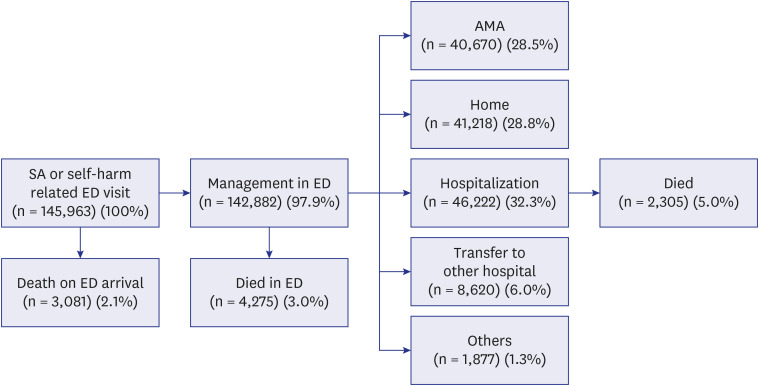
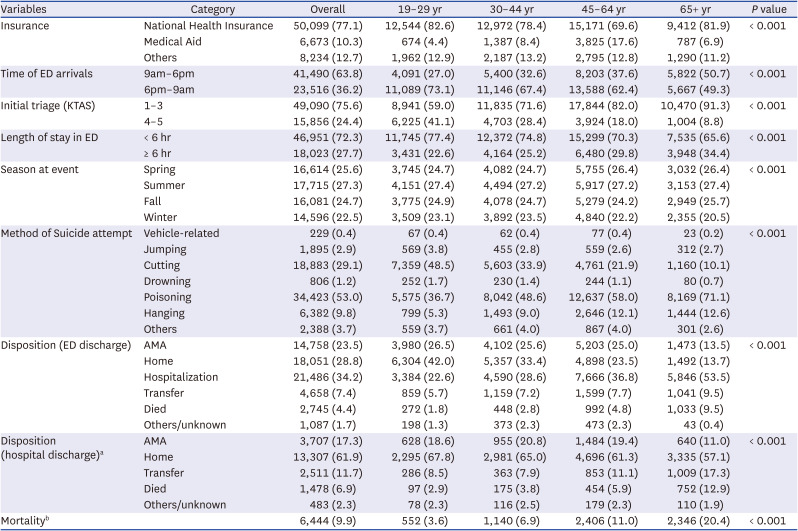
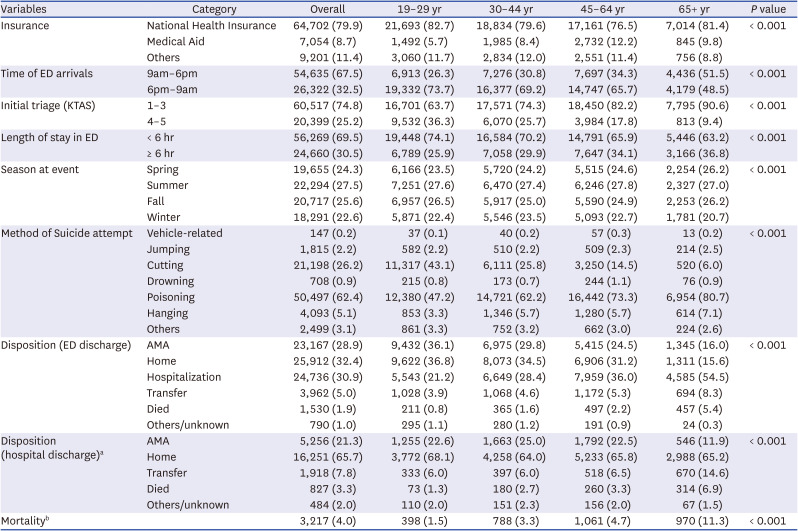




 PDF
PDF Citation
Citation Print
Print



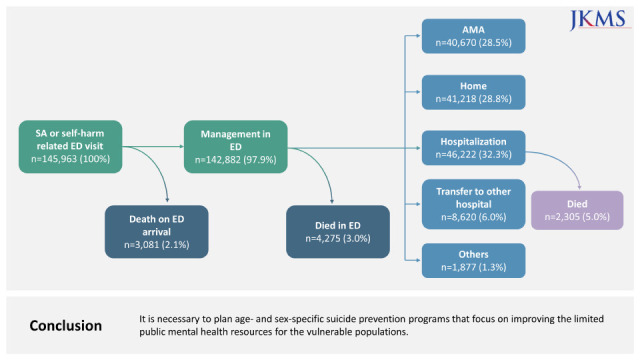
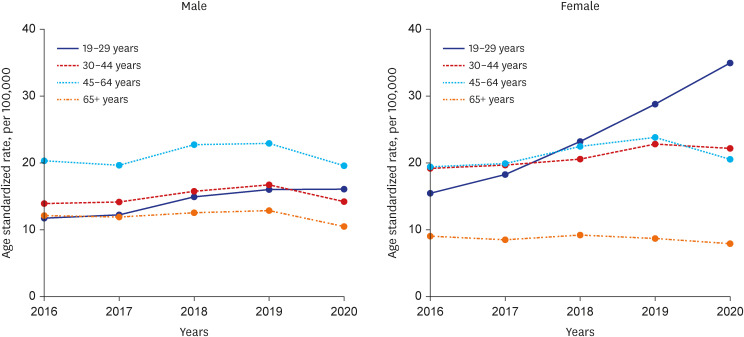
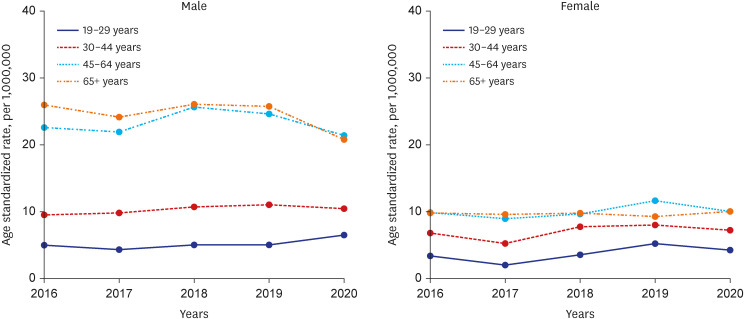
 XML Download
XML Download